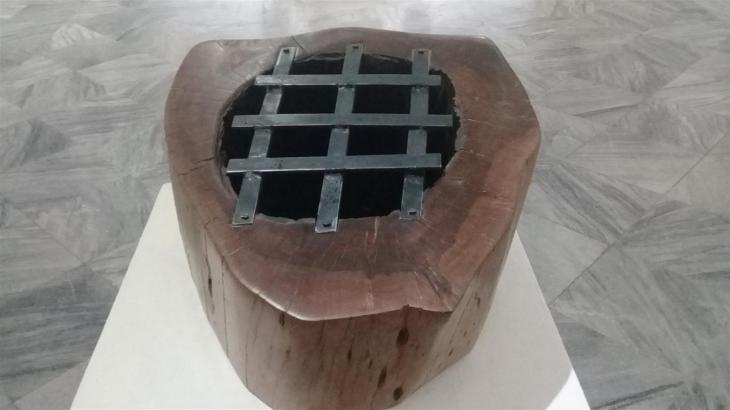
José Antonio Aponte was a free black Cuban man of Yoruba origin born in the late 18th century in Havana. He was an artist and craftsman – a well-known cabinet-maker and sculptor – and lived in what is now known as Los Sitios, a district on the outskirts of the city. He has also been called the forerunner of the struggle for independence of Cuba for his part in the ‘Aponte Conspiracy’ of 1812.
 Due to the increase in the use of slavery in Cuban society in the beginning of the 19th century, looking to secure the place left by Haiti as the major producer of sugar in the world, in the aftermath of the Haitian revolution when plantation owners fled with their slaves to Cuba, there were a series of conspiratorial attempts organized to abolish slavery.
Due to the increase in the use of slavery in Cuban society in the beginning of the 19th century, looking to secure the place left by Haiti as the major producer of sugar in the world, in the aftermath of the Haitian revolution when plantation owners fled with their slaves to Cuba, there were a series of conspiratorial attempts organized to abolish slavery.
In 1808 when Napoleon had invaded Spain this also gave courage to challenge the colonial power. Aponte campaigned in secret for support to end slavery and create a state free of discrimination, and planned a large scale slave rebellion. He was influenced by the French Jacobins and the Haitian revolution. He gained support of black, brown and white Cubans and different social classes across the island in different cities. Aponte and his father and uncles had fought in the military based in Havana and in the United States, and he was a member of the cabildo (mutual support society developed from African traditions) Shango Tedeum.
Unfortunately the plot was discovered by the colonial authorities in March 1812 and 50 people were arrested, tried and the leaders were executed at the gallows.
When Aponte was caught his house was searched and the police seized a library containing a dozen volumes and two manuscripts written and illustrated by Aponte himself, including what became known as The Book of Paintings. Although the books themselves disappeared historians know some of what they contained because at his trial Aponte was forced to describe in detail drawings and paintings he had created, which were claimed to have formed the plan for the rebellion. The images portrayed lush landscapes and religious stories; Roman goddesses and Spanish kings; black men as warriors, emperors, and librarians; Rome and Ethiopia; Havana and the heavens. Aponte is said to have claimed he had made his Book of Paintings to present as a gift to the king of Spain. The book only survived in the written record of the trial.
Aponte was eventually hanged on 9 April 1812. He was also decapitated and his head was placed in a cage in front of his house with his hand on display in another street.
After the revolution in 1959 Aponte’s significance in Cuba’s struggle for independence was rediscovered by historians but for a long time not fully recognised. In 2010, the UNEAC (the artists and writers union) permanent commission against racism and racial discrimination in Cuba was re-named the Aponte Commission. In 2012, the bicentennial of the uprising, several commemorative educational events were held to discuss Aponte’s legacy and formal studies were incorporated into university teaching programmes. The same year, a plaque was installed in commemoration of the repression of the followers of Aponte in Agramonte Park in Camagüey. Since then, two monuments have been installed in his memory: ‘Return of Aponte’ by the artist Alberto Lescay Merencio,positioned in a newly constructed square, on the outskirts of Havana near Peñas Altas and another in the Karl Marx Park, in Centro Habana, made by René Negrín.
This autumn Havana hosted the exhibition ‘Visionary Aponte: Art and Black Freedom’ as well as a conference and literary events. According to the curators, the concept of the exhibition was to re-imagine Aponte’s Book of Paintings’ for the present, inviting us to think about the role of art in making social change and in mitigating the violence of colonialism and its archive. The exhibition brings together artists from Cuba, the Caribbean, the United States and the Cuban and Haitian diaspora. The exhibition moves on to Santiago de Cuba 6 November to 1 December 2019.
The participating artists include: José Bedia (Miami), Leonardo Benzant (New York), Juan Roberto Diago (La Habana), Édouard Duval-Carrié (Miami), Alexis Esquivel (La Habana), Teresita Fernández (New York), Emilio Martínez (Miami), Emilia Adán Martínez (Miami), Nina Angela Mercer (New York), Clara Morera (North Carolina), Glexis Novoa (Miami), Vicki Pierre (Miami), Marielle Plaisir (Miami), Asser Saint-Val (Miami), Jean-Marcel Saint-Jacques (New Orleans), Renée Stout (Washington, D.C.), Alberto Lescay Merencio (Santiago de Cuba) y Gretell Arrate (Santiago de Cuba) y María Magdalena Campos (New York).



The exhibition and events are sponsored by the following organisation in Cuba: Ministry of Culture, UNEAC, the Aponte Commission, the Afroamerica Project, the Casa de las Americas, Centre for Development of the Visual Arts, Havana, Oriente Gallery and the Casa del Caribe, the Caguayo Foundation and the Bacardi Museum in Santiago de Cuba.
The aim of the event is to highlight a hidden part of the history of the Caribbean and to make a bridge between Cuban, Haitian and United States artists. The aim is not about commemorating colonisation, slavery or an act of genocide but to recognise an important milestone in the process of the formation of Cuba’s unique and diverse nationhood. Aponte is a hero of Havana.
Based on an article by Cubarte in spanish
Find more information in English about Aponte in particular the Book of Paintings here

1 thoughts
Comments are closed.